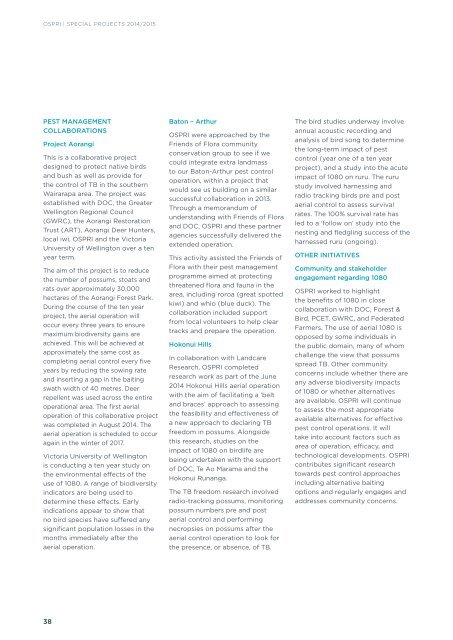Create successful ePaper yourself
Turn your PDF publications into a flip-book with our unique Google optimized e-Paper software.
OSPRI | SPECIAL PROJECTS <strong>2014</strong>/<strong>2015</strong><br />
PEST MANAGEMENT<br />
COLLABORATIONS<br />
Project Aorangi<br />
This is a collaborative project<br />
designed to protect native birds<br />
and bush as well as provide for<br />
the control of TB in the southern<br />
Wairarapa area. The project was<br />
established with DOC, the Greater<br />
Wellington Regional Council<br />
(GWRC), the Aorangi Restoration<br />
Trust (ART), Aorangi Deer Hunters,<br />
local iwi, OSPRI and the Victoria<br />
University of Wellington over a ten<br />
year term.<br />
The aim of this project is to reduce<br />
the number of possums, stoats and<br />
rats over approximately 30,000<br />
hectares of the Aorangi Forest Park.<br />
During the course of the ten year<br />
project, the aerial operation will<br />
occur every three years to ensure<br />
maximum biodiversity gains are<br />
achieved. This will be achieved at<br />
approximately the same cost as<br />
completing aerial control every five<br />
years by reducing the sowing rate<br />
and inserting a gap in the baiting<br />
swath width of 40 metres. Deer<br />
repellent was used across the entire<br />
operational area. The first aerial<br />
operation of this collaborative project<br />
was completed in August <strong>2014</strong>. The<br />
aerial operation is scheduled to occur<br />
again in the winter of 2017.<br />
Victoria University of Wellington<br />
is conducting a ten year study on<br />
the environmental effects of the<br />
use of 1080. A range of biodiversity<br />
indicators are being used to<br />
determine these effects. Early<br />
indications appear to show that<br />
no bird species have suffered any<br />
significant population losses in the<br />
months immediately after the<br />
aerial operation.<br />
Baton – Arthur<br />
OSPRI were approached by the<br />
Friends of Flora community<br />
conservation group to see if we<br />
could integrate extra landmass<br />
to our Baton-Arthur pest control<br />
operation, within a project that<br />
would see us building on a similar<br />
successful collaboration in 2013.<br />
Through a memorandum of<br />
understanding with Friends of Flora<br />
and DOC, OSPRI and these partner<br />
agencies successfully delivered the<br />
extended operation.<br />
This activity assisted the Friends of<br />
Flora with their pest management<br />
programme aimed at protecting<br />
threatened flora and fauna in the<br />
area, including roroa (great spotted<br />
kiwi) and whio (blue duck). The<br />
collaboration included support<br />
from local volunteers to help clear<br />
tracks and prepare the operation.<br />
Hokonui Hills<br />
In collaboration with Landcare<br />
Research, OSPRI completed<br />
research work as part of the June<br />
<strong>2014</strong> Hokonui Hills aerial operation<br />
with the aim of facilitating a ‘belt<br />
and braces’ approach to assessing<br />
the feasibility and effectiveness of<br />
a new approach to declaring TB<br />
freedom in possums. Alongside<br />
this research, studies on the<br />
impact of 1080 on birdlife are<br />
being undertaken with the support<br />
of DOC, Te Ao Marama and the<br />
Hokonui Runanga.<br />
The TB freedom research involved<br />
radio-tracking possums, monitoring<br />
possum numbers pre and post<br />
aerial control and performing<br />
necropsies on possums after the<br />
aerial control operation to look for<br />
the presence, or absence, of TB.<br />
The bird studies underway involve<br />
annual acoustic recording and<br />
analysis of bird song to determine<br />
the long-term impact of pest<br />
control (year one of a ten year<br />
project), and a study into the acute<br />
impact of 1080 on ruru. The ruru<br />
study involved harnessing and<br />
radio tracking birds pre and post<br />
aerial control to assess survival<br />
rates. The 100% survival rate has<br />
led to a ‘follow on’ study into the<br />
nesting and fledgling success of the<br />
harnessed ruru (ongoing).<br />
OTHER INITIATIVES<br />
Community and stakeholder<br />
engagement regarding 1080<br />
OSPRI worked to highlight<br />
the benefits of 1080 in close<br />
collaboration with DOC, Forest &<br />
Bird, PCET, GWRC, and Federated<br />
Farmers. The use of aerial 1080 is<br />
opposed by some individuals in<br />
the public domain, many of whom<br />
challenge the view that possums<br />
spread TB. Other community<br />
concerns include whether there are<br />
any adverse biodiversity impacts<br />
of 1080 or whether alternatives<br />
are available. OSPRI will continue<br />
to assess the most appropriate<br />
available alternatives for effective<br />
pest control operations. It will<br />
take into account factors such as<br />
area of operation, efficacy, and<br />
technological developments. OSPRI<br />
contributes significant research<br />
towards pest control approaches<br />
including alternative baiting<br />
options and regularly engages and<br />
addresses community concerns.<br />
38


